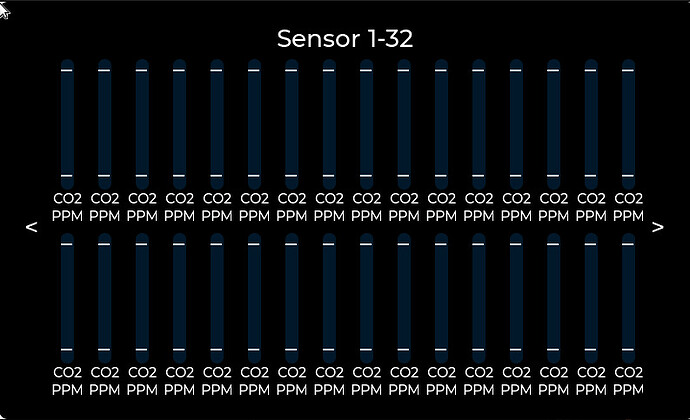Hi, I’m currently building a visualization of a large Sensor group for a Alarm system. I need to be able to visualize 32 Sensors values at the same time.
I am trying to add a scale to my Bars to visualize a minimum and maximum Value. The Performance of my entire breaks down when doing that. I really don’t know why.
static void BarInsideFrameCreate(lv_obj_t *pParent, BarObject_t *pBarObject)
{
static bool styleInitialized = false;
const int16_t barWidth = 15; // Adjust the width to fit text
const int16_t barHeight = 140; // Adjust the height for appearance clarity
const int16_t textHeight = 20;
// Define grid columns and rows for the bar layout
static int32_t barColumns[] = {barWidth, barWidth, barWidth, LV_GRID_TEMPLATE_LAST};
static int32_t barRows[] = {barHeight, textHeight, textHeight, textHeight, LV_GRID_TEMPLATE_LAST};
lv_obj_set_style_pad_gap(pParent, 0, 0);
lv_obj_set_grid_dsc_array(pParent, barColumns, barRows);
lv_obj_set_size(pParent, barWidth, barHeight); // Parent size based on grid dimensions
lv_obj_center(pParent); // Center the parent object
static lv_style_t labelStyle;
if(styleInitialized == false)
{
lv_style_init(&labelStyle);
lv_style_set_text_color(&labelStyle, lv_color_make(0xFF, 0xFF, 0xFF)); // White text
lv_style_set_text_font(&labelStyle, &lv_font_montserrat_16); // Font for labels
}
// lv_obj_add_style(pParent, &mainStyle, 0); // Apply main style to the parent bar
// Create text fields inside the bar
lv_obj_t *label1 = lv_label_create(pParent);
lv_label_set_text(label1, "CO2"); // Add text
lv_obj_set_grid_cell(label1, LV_GRID_ALIGN_CENTER, 0, 3,
LV_GRID_ALIGN_CENTER, 1, 1); // Position in cell (0, 0)
lv_obj_add_style(label1, &labelStyle, 0); // Style for label1
lv_obj_t *label2 = lv_label_create(pParent);
lv_label_set_text(label2, "PPM"); // Add text
lv_obj_set_grid_cell(label2, LV_GRID_ALIGN_CENTER, 0, 3,
LV_GRID_ALIGN_CENTER, 2, 1); // Position in cell (1, 0)
lv_obj_add_style(label2, &labelStyle, 0); // Style for label2
// Styles
static lv_style_t mainStyle;
if(styleInitialized == false)
{
lv_style_init(&mainStyle);
lv_style_set_bg_color(&mainStyle, lv_color_make(0x00, 0x0, 0x0)); // Dark blue background
lv_style_set_radius(&mainStyle, 5); // Rounded corners for the bar
}
lv_obj_t *pBar = screenAddBarToGrid(pParent, 1, 1, 0, 1);
lv_obj_add_style(pBar, &mainStyle, LV_PART_MAIN); // Apply main style to the bar
(void) screenAddScaleToBar(pParent); // Mega buggy...
if(pBarObject!=NULL)
{
pBarObject->pParent = pParent;
pBarObject->pBar = pBar;
pBarObject->pLabel1 = label1;
pBarObject->pLabel2 = label2;
}
styleInitialized = true; // Mark styles as initialized
}
lv_obj_t *screenAddScaleToBar(lv_obj_t *pBar)
{
static bool styleInitialized = false;
lv_obj_t *pScale = lv_scale_create(pBar);
lv_obj_set_size(pScale, lv_obj_get_width(pBar), lv_obj_get_height(pBar));
lv_scale_set_mode(pScale, LV_SCALE_MODE_VERTICAL_LEFT);
lv_obj_align(pScale, LV_ALIGN_CENTER, 0, 0);
lv_scale_set_total_tick_count(pScale, 100);
lv_scale_set_major_tick_every(pScale, 10);
lv_obj_set_style_length(pScale, 20, LV_PART_INDICATOR);
lv_scale_set_range(pScale, 0, 100);
static const char *custom_labels[3] = {"", "", NULL};
lv_scale_set_text_src(pScale, custom_labels);
static lv_style_t indicatorStyle;
if (styleInitialized == false)
{
lv_style_init(&indicatorStyle);
////////////////////////////
// Major tick properties
////////////////////////////
lv_style_set_line_color(&indicatorStyle, lv_color_hex(0xFF0000));
lv_style_set_width(&indicatorStyle, 5U); // Tick length
lv_style_set_line_width(&indicatorStyle, 0U); // Tick width
}
lv_obj_add_style(pScale, &indicatorStyle, LV_PART_INDICATOR);
static lv_style_t mainLineStyle;
if (styleInitialized == false)
{
lv_style_init(&mainLineStyle);
////////////////////////////
// Main line properties
////////////////////////////
lv_style_set_line_color(&mainLineStyle, lv_color_hex(0xFF0000));
lv_style_set_line_width(&mainLineStyle, 0U); // Tick width
}
lv_obj_add_style(pScale, &mainLineStyle, LV_PART_MAIN);
lv_obj_center(pScale);
////////////////////////////
// Add a section
////////////////////////////
static lv_style_t section_label_style;
if (styleInitialized == false)
{
lv_style_init(§ion_label_style);
/////////////////////////
// Label style properties
/////////////////////////
lv_style_set_text_font(§ion_label_style, LV_FONT_DEFAULT);
lv_style_set_text_color(§ion_label_style, lv_color_hex(0xFFFFFF));
lv_style_set_text_letter_space(§ion_label_style, 10);
lv_style_set_text_opa(§ion_label_style, LV_OPA_50);
lv_style_set_line_color(§ion_label_style, lv_color_hex(0xFFFFFF));
lv_style_set_width(§ion_label_style, 20U); // Tick length
lv_style_set_line_width(§ion_label_style, 2U); // Tick width
lv_style_set_width(§ion_label_style, 10U); // Tick length
}
/////////////////////////
// Configure section styles
/////////////////////////
lv_scale_section_t *section = lv_scale_add_section(pScale);
lv_scale_section_set_range(section, 1, 10);
lv_scale_section_set_style(section, LV_PART_INDICATOR, §ion_label_style);
lv_scale_section_t *section_2 = lv_scale_add_section(pScale);
lv_scale_section_set_range(section_2, 85, 95);
lv_scale_section_set_style(section_2, LV_PART_INDICATOR, §ion_label_style);
styleInitialized = true; // Mark styles as initialized
return pScale;
}
What am I missing here?
Best regards
